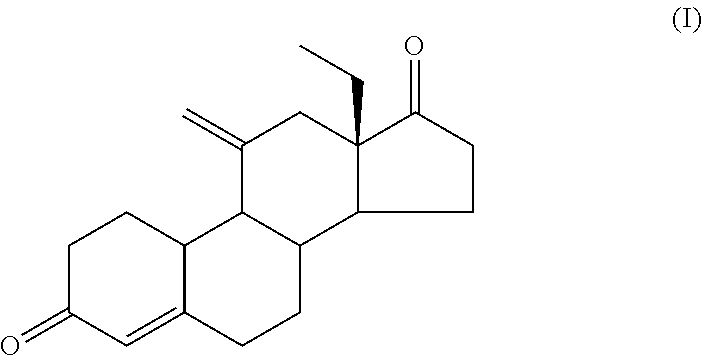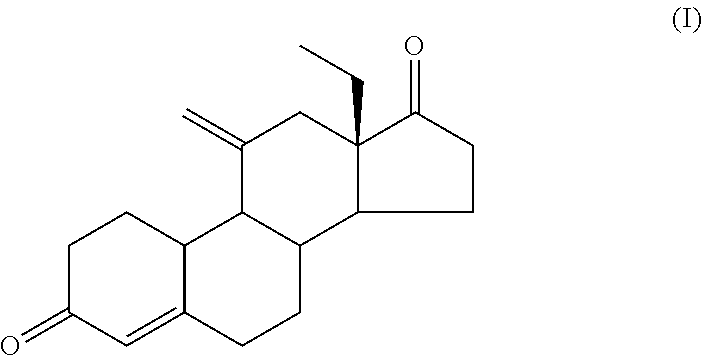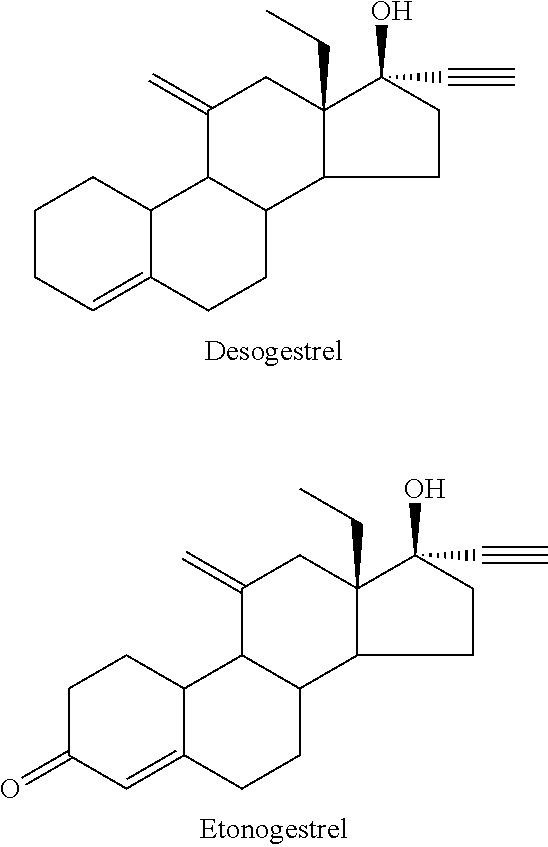Process for Preparing 11-Methylene-18-Methyl-Estr-4-En-3, 17-Dione, Useful as Intermediate Compound for the Synthesis of Molecules Having Pharmacological Activity
a technology of methylestr-4en-3 and methylestr-4en-3, which is applied in the field of industrial synthesis of 11-methylene18methylestr-4en-3, 17-dione, can solve the problems of inapplicability of synthesis to prepare a product, method not having a practical level of synthetic utility, and inapplicability of synthesis to large-scale production, so as to reduce the overall number of reaction steps
- Summary
- Abstract
- Description
- Claims
- Application Information
AI Technical Summary
Benefits of technology
Problems solved by technology
Method used
Image
Examples
example 1
Preparation of 18-methyl-estra-4-en-3,11,17-trione, Compound (III)
[0053]
[0054]50 g of compound (II) are dissolved in 125 mL DMSO; 229 mL TEA are then added. Keeping the temperature between 25° C. and 35° C., 79 g of PySO3 dissolved in 225 mL DMSO are added. Exothermy is observed during the addition. Stirring is continued for 3 hours at 25° C.
[0055]Reaction check via HPTLC: reaction ended (only a halo is observed, which corresponds to the starting product).
[0056]The reaction mixture is transferred to a solution of 375 mL glacial acetic acid in 750 mL water; exothermy (temperature from RT to 40° C.) and formation of a precipitate are observed during the addition. The pH is checked and found to be about 4. The solution is cooled to 0° C. for 1 hour, filtered and dried in stove at T=60° C. for 16 hours, yielding 34.53 g of product. Mother liquor is re-extracted with 500 mL AcOiPr (1 time 300 mL, 2 times 100 mL).
[0057]The solvent is distilled under reduced pressure at T=50° C.
[0058]150 m...
example 2
Preparation of the Acetal of Formula (IV), where R1+R2=—CH2—Ch2—
[0068]
[0069]38 g of intermediate product (III) are dissolved in 1900 mL methylene chloride. The following is sequentially added: 37.6 mL 1,2-etandiol, 38 mL triethyl orthoformate and 1.23 mL 98% H2SO4. Keeping the temperature between 18 and 20° C., it is stirred for 1.5 hours.
[0070]Reaction check via HPTLC: reaction ended.
[0071]The following is sequentially added to the reaction solution: 0.9 mL pyridine, 76 mL 10% aqueous solution of NaHCO3, 380 mL water. The pH of the aqueous phase is measured and found equal to 7. The biphasic mixture is vigorously stirred for at least 20 minutes. The phases are separated. The organic phase is washed with water (304 mL twice).
[0072]The organic phase is concentrated under reduced pressure at a temperature of about 45° C. The resulting solid is completely dissolved in 75 mL methylene chloride. 70 mL MTBE is added. The methylene chloride is distilled at atmospheric pressure at 55° C. Th...
example 3
Preparation of 17-hydroxy-18-methyl-estr-5-en-3,11-dione 3,3′-acetal (V)
[0080]
[0081]32 g of compound (IV) are dissolved in 656 mL methylene chloride. 656 mL methanol and 31.2 g CeCl3.7H2O are added and the solution is cooled to 0° C. 2.24 g NaBH4 are then added in 4 portions over 20 minutes, observing a light exothermy (the temperature of the reaction mixture reaches about 5-10° C.) and gas generation. A clouding of the reaction mixture is observed. Stirring is continued for 1 hour at 0° C.
[0082]Reaction check in HPTLC: reaction ended, residual compound (IV) less than 2%.
[0083]A solution of 1.6 mL acetic acid in 819 mL water is added to the reaction mixture; the pH is equal to 6.
[0084]The solvent is distilled under reduced pressure at 45° C., observing the formation of a precipitate. It is cooled to 0° C. for at least one hour. It is filtered and washed with water (160 mL three times). The solid is stirred with 128 mL toluene (the solid does not dissolve completely). The solvent is ...
PUM
 Login to View More
Login to View More Abstract
Description
Claims
Application Information
 Login to View More
Login to View More - R&D
- Intellectual Property
- Life Sciences
- Materials
- Tech Scout
- Unparalleled Data Quality
- Higher Quality Content
- 60% Fewer Hallucinations
Browse by: Latest US Patents, China's latest patents, Technical Efficacy Thesaurus, Application Domain, Technology Topic, Popular Technical Reports.
© 2025 PatSnap. All rights reserved.Legal|Privacy policy|Modern Slavery Act Transparency Statement|Sitemap|About US| Contact US: help@patsnap.com



